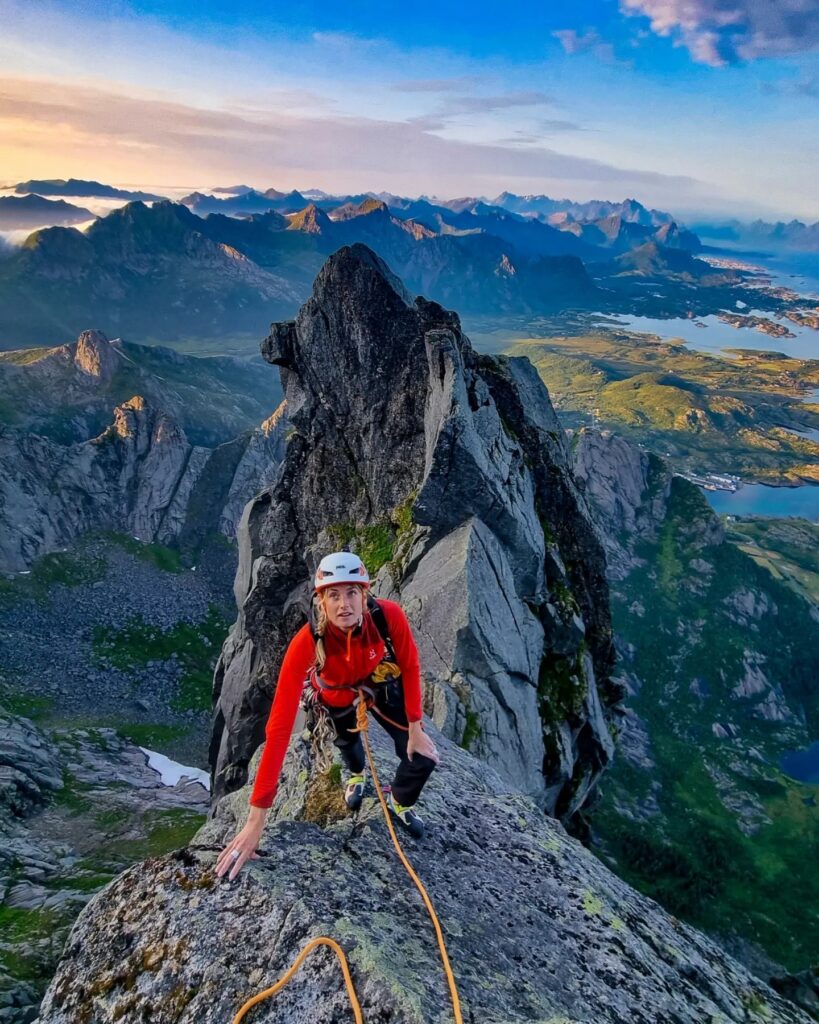Storpillaren rises like a prayer from the climber’s bible, stretching its way skywards from the Kalle valley. The Great Pillar, as translated in English, is one of Lofoten’s abundant monolith cliffs.
Yet upon the voices of local climbers, a tremble does enter their verse when talking about Storpillaren.
Graced by the presence of Matilda Sunderland and her partner William, a minimalist trail wound its way through thickets and brash, depositing us without direction to trudge up boulder fields. Be it faith or relatively good interpretation skills of a dismal description, the way presented itself.
Below the pillar’s towering wall, we stopped and breathed in the silence like smoke. Two hours in, the approach now continued negotiating runout unprotected and unmarked slabs. Here was the point of full commitment. Are you in? Yea, fuck it, let’s do it.
A harrowing half an hour later we had summited the ascent. Catching up with a team of two who were just bailing off the second pitch. When questioned, they told us they had no wish to continue. The unmarked glaciated slabs had them spooked. On a route this intimidating you need more than ability; you need belief. The mind games of Storpillaren come fast and hard before you step foot on the wall. Power to them; you have to know when to walk away.
As our energy levels gradually collapsed, the surroundings seemingly rose. Matilda is known for hard sport routes; the world of chossy, runout, body position-dependent dihedrals and savage energy-depleting crack climbing is entirely new to her. She cracks on with finesse and style, cruising up all her pitches even when she’s well into the zone 2 enjoyment stage.
The second-to-last pitch is infamous. Rated X for potential death, each person when mentioning this route had breathed sighs of caution, reciting how to get around climbing it by abbing into a side gully and doing two pitches of grass pulling it could be avoided. But then surely you haven’t done the full route?
After equalizing a couple of thin offset RPs and locating a sidewise microwire in an obvious slot, the move offered little resistance. For those who are used to climbing in the UK and capable of freeing the harder pitches, I’d wager this would feel fine for you. Runout E1?
On a perfect descent, the route down is obvious. The rhythm of walking and fatigue sends you to a meditative place, one of reflection. The opposite is true of this occasion. Of those who have endured the slabs and successfully navigated the climbing, there are many accounts of teams going wrong here. The sting in the tail comes in the form of a 3-hour descent. Poisoned legs saw us down to the car and our friends. They cooked us up some tacos before finally getting to bed under the midnight sun at 3 AM.
I’m very psyched that Matilda was along for this adventure. Stepping away from the bolts and committing to a massive 13/14-hour day on an Adventurous 600m route is not a pushover. At no point is it not hard work, even if you do climb 9a.
It has to be said that the Rockfax description of this route is woeful. The approach is not mentioned, and the pitches on the route and descriptions are an interpretation at best. There is no mention of the descent or how to safely get off. It’s like leading lambs to the slaughter.
I’ve written a more detailed account on UKC about how not to get lost. If you plan to climb this, use the Rockfax and Peakbooks description.

